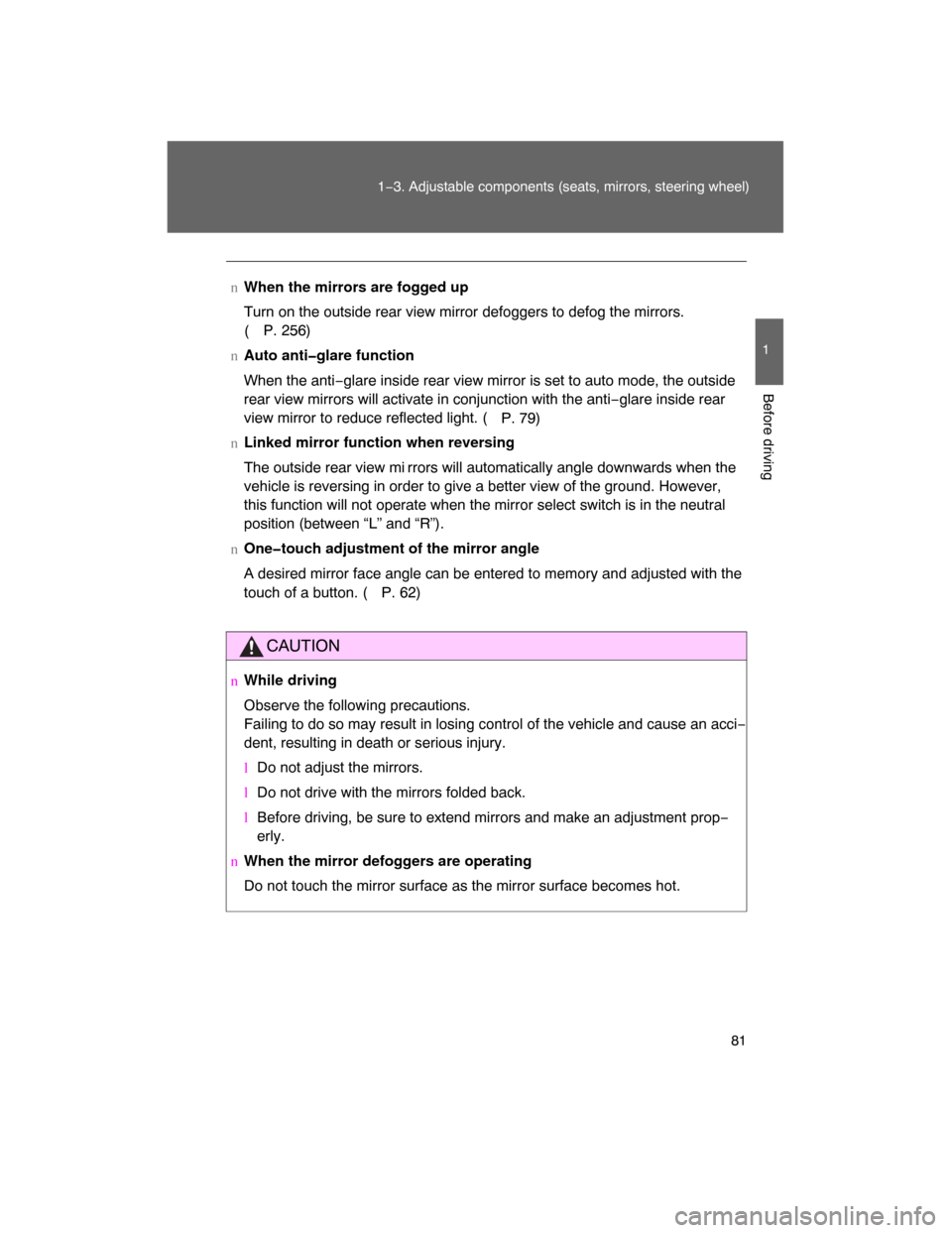Page 80 of 531

81
1−3. Adjustable components (seats, mirrors, steering wheel)
1
Before driving
nWhen the mirrors are fogged up
Turn on the outside rear view mirror defoggers to defog the mirrors.
(P. 256)
nAuto anti�glare function
When the anti−glare inside rear view mirror is set to auto mode, the outside
rear view mirrors will activate in conjunction with the anti−glare inside rear
view mirror to reduce reflected light. (
P. 79)
nLinked mirror function when reversing
The outside rear view mi rrors will automatically angle downwards when the
vehicle is reversing in order to give a better view of the ground. However,
this function will not operate when the mirror select switch is in the neutral
position (between “L” and “R”).
nOne�touch adjustment of the mirror angle
A desired mirror face angle can be entered to memory and adjusted with the
touch of a button. (
P. 62)
CAUTION
nWhile driving
Observe the following precautions.
Failing to do so may result in losing control of the vehicle and cause an acci−
dent, resulting in death or serious injury.
lDo not adjust the mirrors.
lDo not drive with the mirrors folded back.
lBefore driving, be sure to extend mirrors and make an adjustment prop−
erly.
n
When the mirror defoggers are operating
Do not touch the mirror surface as the mirror surface becomes hot.
Page 141 of 531

143
2−1. Driving procedures
2
When driving
CAUTION
lDo not under any circumstances shift the shift lever to “P” or “R” while the
vehicle is moving.
Doing so can cause significant damage to the transmission and may result
in a loss of vehicle control.
lDo not shift the shift lever to “N” while the vehicle is moving.
Doing so may cause the engine brake not to operate properly and lead to
an accident.
lDo not turn the engine off while driving.
The power steering and brake actuator
will not operate properly if the
engine is not running.
lUse engine braking (downshift) to maintain a safe speed when driving
down a steep hill.
Using the brakes continuously may cause the brakes to overheat and lose
effectiveness. ( P. 154)
lWhen stopped on an inclined surface, use the brake pedal and parking
brake to prevent the vehicle from rolling backward or forward and causing
an accident.
lDo not adjust the position of the steering wheel, the seat, or the inside or
outside rear view mirrors while driving.
Doing so may result in a loss of vehicle control that can cause accidents
that may result in death or serious injury.
lAlways check that all passengers’ arms, heads or other parts of their bod−
ies are not outside the vehicle, as this may result in death or serious injury.
l
Do not drive in excess of the speed limit. Even if the legal speed limit per−
mits it, do not drive over 85 mph (140 km/h) unless your vehicle has high−
speed capability tires. Driving over 85 mph (140 km/h) may result in tire
failure, loss of control and possible injury. Be sure to consult a tire dealer
to determine whether the tires on your vehicle are high−speed capability
tires or not before driving at such speeds.
Page 172 of 531
174 2−3. Operating the lights and wipers
nThe windshield wiper and washer can be operated when
The “ENGINE START STOP” switch is in IGNITION ON mode.
n“INT” mode
nIf no windshield washer fluid sprays
Check that the washer nozzles are not blocked if there is washer fluid in the
windshield washer fluid reservoir.
nIn extremely hot or cold weather
The system will turn off if the windshield gets extremely hot (at more than
176 F [80 C]) or cold (at less than −14 F [−10 C]).
nWindshield wiper features
The rear window and outside rear view mirror defoggers automatically turn
on when you operate the wipers.
nCustomization
Settings (e.g. drip prevention function) can be changed. (
P. 519)
Intermittent wiper interval adjust−
ment (increase)
Intermittent wiper interval adjust−
ment (decrease)
ITY23C030
Page 234 of 531

236 2−5. Driving information
nBefore towing
Check that the following conditions are met:
lThe vehicle’s tires are properly inflated.
lTrailer tires are inflated according to the trailer manufacturer ’s recom−
mendation.
lAll trailer lights work.
lAll lights work each time you connect them.
lThe trailer ball is set up at the proper height for the coupler on the trailer.
lThe vehicle remains level when a loaded or unloaded trailer is hitched.
Do not drive if the vehicle is not level, and check for improper tongue
load, overloading, worn suspension, or other possible causes.
lThe trailer cargo is securely loaded.
lThe rear view mirrors conform to all applicable federal, state/provincial or
local regulations. If they do not, install rear view mirrors appropriate for
towing purposes.
nBreak�in schedule
Toyota recommends that you do not use a new vehicle or a vehicle with any
new power train components (engine, transmission, differential, wheel bear−
ings, etc.) to tow a trailer for the first 500 miles (800 km) of driving.
nMaintenance
lIf you tow a trailer, your vehicle will require more frequent maintenance
due to the additional load. (See “Scheduled Maintenance Guide” or
“Owner ’s Manual Supplement”.)
lRetighten the fixing bolts of the towing ball after approximately 600 miles
(1000 km) of trailer towing.
Page 252 of 531
256
3−1. Using the air conditioning system and defogger
Rear window and outside rear view mir ror defoggers
nThe rear window and outside rear vi ew mirror defoggers can be oper�
ated when
The “ENGINE START STOP” switch is in IGNITION ON mode.
CAUTION
nWhen the outside rear view mirror defoggers are on
Do not touch the rear view mirror surfaces, as they can become very hot and
burn you.
These features are used to defog the rear window, and to remove
raindrops, dew and frost from the outside rear view mirrors.
With navigation system
On/off
The defoggers will automati−
cally turn off after 15 to 225
minutes. The operation time
changes according to the
ambient temperature and vehi−
cle speed. Pressing the switch
again also turns the defoggers
off.
Without navigation system
Page 415 of 531
420 4−3. Do−it−yourself maintenance
61 HEAD RL15 A
Headlight low beam (right)
62 EFI NO.27.5 AAFM, EVP VSV, 02 SSR, KEY
OFF PMP, AI DRIVER, AI EX
VSV, ACIS VSV
63 RR A/C NO.27.5 A
No circuit
64 DEF NO.25 A
Outside rear view mirror heater
FuseAmpereCircuit
Page 418 of 531
423
4−3. Do−it−yourself maintenance
4
Maintenance and care
16 RR DOOR RH 20 A Power windows
17 MIR 15 AMirror ECU, outside rear view
mirror heater
18 RR DOOR LH 20 A Power windows
19 FR DOOR LH 20 A Power windows
20 FR DOOR RH 20 A Power windows
21 RR FOG 7.5 A No circuit
22 A/C 7.5 A Air conditioning system
23 AM1 5 A No circuit
24 TI & TE 15 A Tilt and telescopic steering
25 FR P/SEAT RH 30 A Front seat adjustment
26 PWR OUTLET 15 A Power outlet
27 OBD 7.5 A DLC3
28 PSB 30 A Pre−collision seat belt
29 DOOR NO.1 25 A Main body ECU
30 FR P/SEAT LH 30 A Front seat adjustment
31 INVERTER
15 A Inverter
FuseAmpereCircuit
Page 524 of 531

533
Alphabetical index
Wattage ................................ 503
Front passenger’s seat belt
reminder light ........................ 452
Front seats
Adjustment ............................. 51
Driving position memory ......... 62
Front side marker light
Replacing light bulbs ............ 426
Wattage ................................ 503
Front turn signal lights
Replacing light bulbs ............ 426
Wattage ................................ 503
Fuel
Capacity ............................... 496
Fuel gauge ........................... 160
Fuel pump shut off system ... 446
Gas station information ........ 540
Information ........................... 504
Refueling ................................ 89
Type ..................................... 504
Fuel door .................................... 89
Fuel filler door ........................... 89
Fuel pump shut off
system ................................... 446
Fuses ........................................ 413
Garage door opener ................ 352
Gas station information .......... 540
Gauges ..................................... 160
Glove box ................................. 329
Glove box light ........................ 329
Head restraints
Adjusting................................. 65
Headlight cleaner .................... 177
Headlights
Replacing light bulbs ............ 426
Switch ................................... 170
Wattage ................................ 503
Heaters
Seat heaters ......................... 346Hill�start assist control ............ 201
Hood .......................................... 374
Hooks
Cargo hook............................ 350
Tie−down hooks..................... 350
I/M test....................................... 370
Identification
Engine ................................... 495
Vehicle .................................. 495
Ignition
Engine switch ........................ 149
Keys ........................................ 24
Ignition switch........................ 149
Ignition switch
.......................... 149
Illuminated entry system ......... 325
Indicator lights ......................... 163
Initialization
Items to initialize.................... 523
Inside rear view mirror .............. 79
Instrument panel light
control .................................... 161
Interior lights
Interior lights.......................... 325
Switch.................................... 326
Wattage ................................. 503
Jack
Replacing the wheel .............. 463
Jack handle .............................. 463
KDSS ......................................... 201
Keyless entry.............................. 26
Keys
Electronic key .......................... 24
If you lose your keys ............. 479
If your electronic key
battery is discharged... 410, 481
Ignition switch........................ 149
Keyless entry........................... 26
Key number ............................. 24
G
H
I
J
K